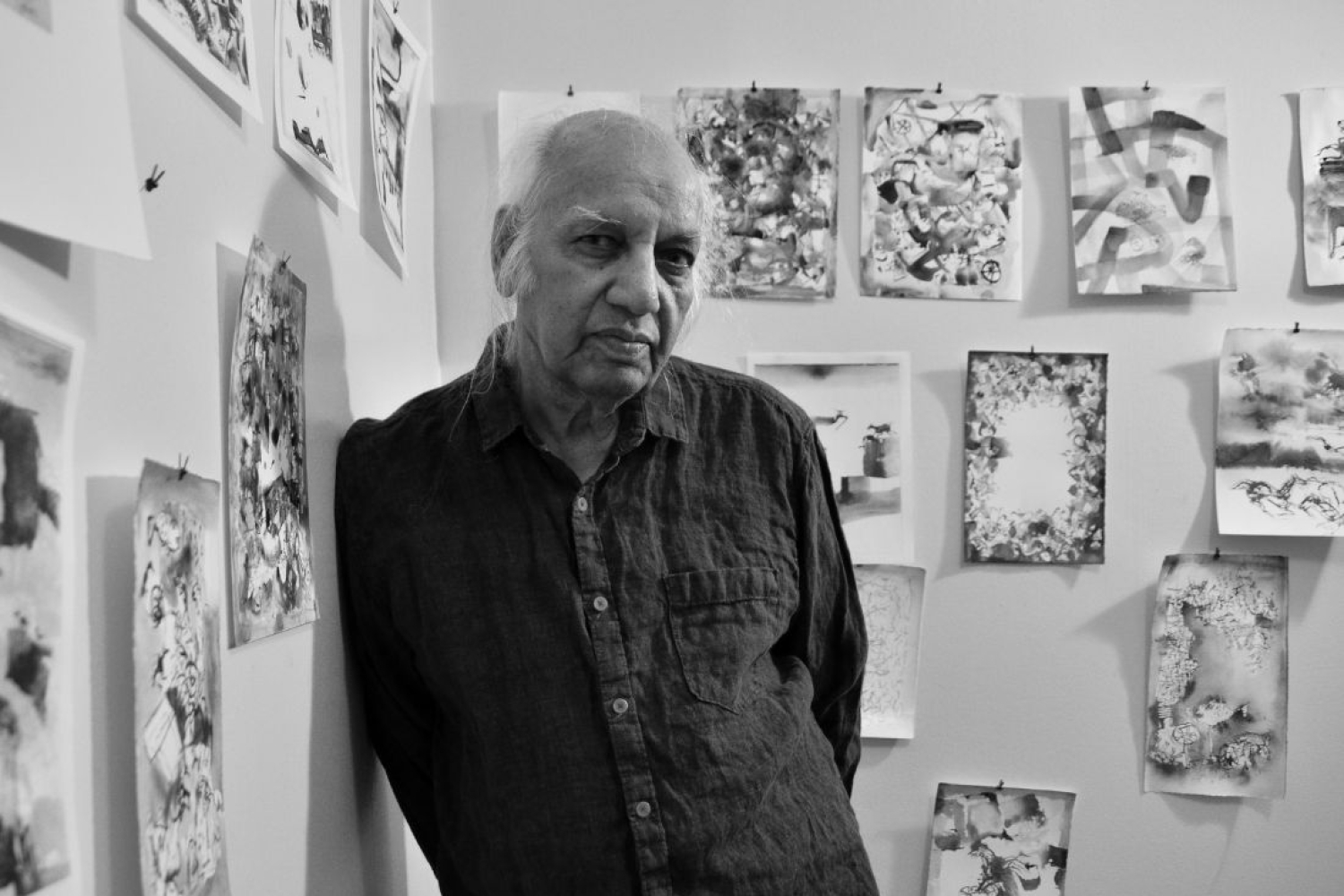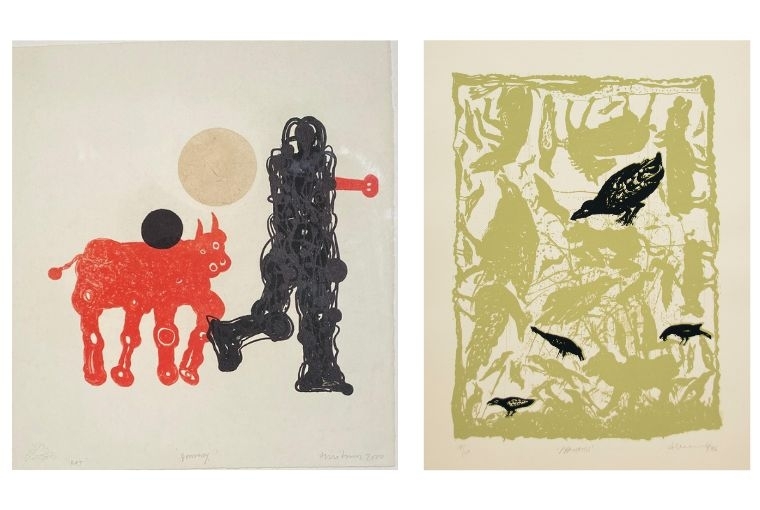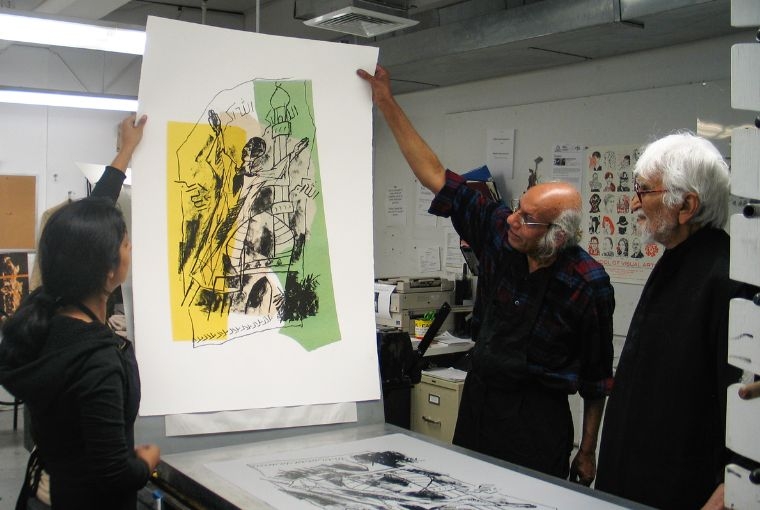

National Gallery of Modern Art in Bangalore is showcasing a monumental retrospective exhibition by the master printmaker, Devraj Dakoji, with over 350 of his drawings, paintings and prints created from the 1960s till the present. The veteran artist lives between New York and New Delhi, and is still very close to his craft of making prints. He studied at the Tamarind Institute in New Mexico back in the early 90s, after which he and his wife, Prathibha, who is also an artist, started a printmaking studio in Delhi called Atelier 221. At this studio, they collaborated with various contemporary artists like MF Husain, VS Gaitonde, Manu and Madhvi Parekh, and many more to make lithographs or serigraphs of their works. Life took them to New York next, where Devraj began working with the prestigious Robert Blackburn Print Workshop.
The retrospective opened last weekend with a special event and a talk by Gulam Mohammed Sheikh, and will run till 29th October. We present a highlight of his practice with a conversation about his journey in the arts.
You've had a long and prolific career as a printmaker, with works spanning from the 1960s to the present day. Can you share some insights into the evolution of your artistic style and techniques over the years?
I first became interested in printmaking after seeing the work of the German artist Kathe Kollwitz. Her lithographs, woodcuts and etchings were on display at a graphic exhibition, organised by the Hyderabad Art Society at Ajanta Pavilion. We didn’t have a printmaking department in college then but I had this urge to explore the medium. I applied for the Andhra Pradesh Lalit Kala Akademi scholarship for printmaking at the Faculty of Fine Arts in Baroda. Shri Jyoti Bhatt had just come back from the USA, where he was on a Fulbright scholarship for Printmaking, but he was teaching painting. While in Baroda, I learned colour lithography from Shri Jogalekar and explored techniques and subjectively. Etching wasn’t taught at the time but I learnt the techniques from Shri Jyoti Bhatt after he got an etching press from Ravi Engineering.
I recollect that Bhupen Kakkar, Gulam Mohammed Sheikh, VR Patel, JS Rawal and a few other students, including me, were learning etching from him. He also gave me a small booklet to read on Japanese woodcuts to understand black and white separation. Shortly after, KG Subramanyam returned from the USA, where he had also been on a Fulbright scholarship. I used to show him my prints and he would guide me. During those days I assisted Jyoti sir in bringing out his colour prints. It gave me more technical knowledge about editions or multiples in printmaking. My work shifted from landscape to combining abstract nature forms. I was greatly influenced by a trip to Kashmir and the landscape there, especially the colour of the water. Birth of Jhelum was my first abstract watercolour painting. I did a large watercolour that was 4ft x 3ft, which I have since lost.

Your collaboration with various contemporary artists, such as MF Husain and VS Gaitonde, in creating lithographs and serigraphs is impressive. Could you tell us about the creative process and challenges involved in translating their works into print form?
I often have to explain the difference between a printmaker and a master printmaker. The title I have of a master printmaker is due to my training in collaborating with artists and creating editions of their prints. My training helped me learn important technical information about the mixing of ink and making editions. Printmaking is a very technical medium and different kinds of prints have different processes.
Once, MF Hussain came to Garhi Artist Studio at Lalit Kala Akademi, where I was in charge of the Printmaking Department, and requested me to collaborate with him on an edition. I had to refuse as we didn’t have the professional tools that I had seen at Gemini G.E.L., The Crowns Studio and Robert Blackburn Printmaking Workshop in New York. Later at Robert Blackburn, I got the opportunity to help him bring out an edition of his prints using the chine collé technique.
After establishing Atelier 221 in Delhi, you eventually moved to New York and worked with the renowned Robert Blackburn Print Workshop. How did this shift influence your work, and what unique opportunities did it offer for your artistic practice?
Atelier 2221 was founded and set up in 1995 after I did my training to further my knowledge of bringing out editions as a master printmaker at the Robert Blackburn Studio in New York, where I collaborated with several international artists, including MF Hussain from 1993 to 1994. We couldn’t make Atelier 2221 sustainable so I decided to go back and teach, as well as make collaborative prints as that was my passion. It was especially challenging to bring large editions manually in five to six colours of 40 x 30 paper. I collaborated with sculptors and known American painters, as well as international artists. As far as my own work, I am inspired by nature and I make watercolours and prints like varied lithographs or Sumi ink works.

Your retrospective exhibition at the National Gallery of Modern Art in Bangalore is a significant milestone in your career. Could you highlight a few key pieces or moments from the exhibition that hold special significance for you and reflect your artistic journey?
NGMA is India's most prestigious museum and I feel honoured to have this opportunity to exhibit my work spanning five decades. The highlight was that we were able to borrow from other public and private collections. I was very touched that the Delhi Art Gallery (DAG) and the Mukundan family loaned us some of my early works from their collections. I also shared around 500 works from my own personal collection from different phases of my career, from the Landscapes and the Organic series to my Rock and Pranamu series and the more recent Wheel of Life series. This was also the first time I was showcasing my original collaborative prints made at Robert Blackburn Printmaking Workshop—The Elizabeth Foundation for the Arts and Atelier 2221 that show my skill in printmaking and collaborating with national and international artists. I was also able to make a trip to Hyderabad to see some of my very early works at the Salar Jung Museum and the State Akademi. It was very moving to see them after 60 years. Unfortunately, we couldn’t get them in time for the NGMA show.
Living and working between New York and New Delhi, you've experienced different artistic landscapes and cultural influences. How has this dual residence shaped your artistic perspective and impacted the themes and subjects you explore in your prints?
Though I stay in New York, I also keep in touch with India. My main reason to be in New York are the excellent printmaking materials and facilities, and the honour I receive there for teaching as well as collaborating with international artists while working on my prints. My roots are very much in India and the life around me is fascinating to express, whether it’s in my watercolour paintings and Sumi ink works or lithographs and etchings. Nature is the same everywhere but how you see it and express it is one’s own unique style.
Words Hansika Lohani
Date 02.10.2023